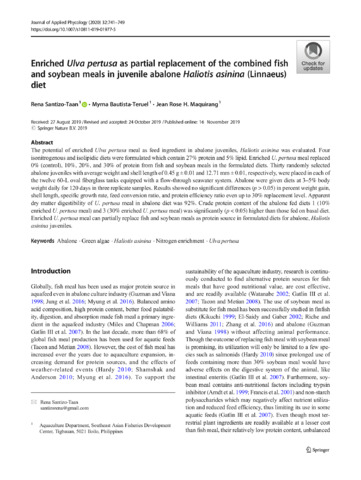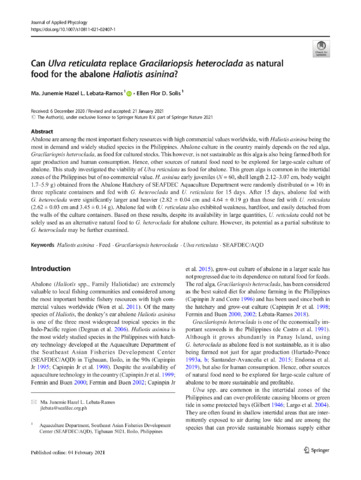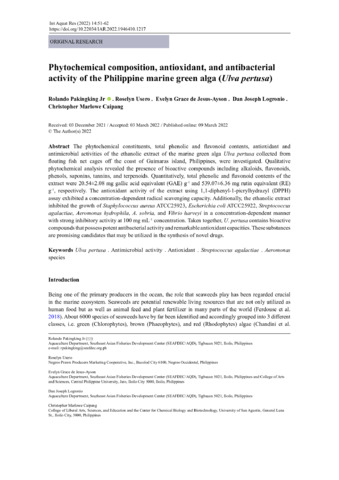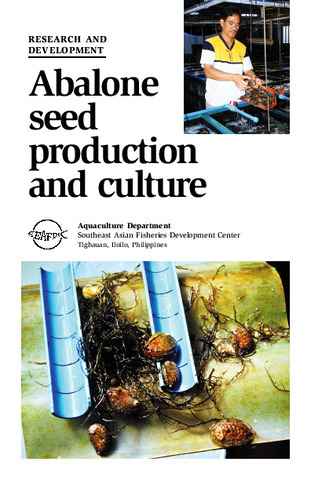Enriched Ulva pertusa as partial replacement of the combined fish and soybean meals in juvenile abalone Haliotis asinina (Linnaeus) diet
Share
စိတ္တဇ
The potential of enriched Ulva pertusa meal as feed ingredient in abalone juveniles, Haliotis asinina was evaluated. Four isonitrogenous and isolipidic diets were formulated which contain 27% protein and 5% lipid. Enriched U. pertusa meal replaced 0% (control), 10%, 20%, and 30% of protein from fish and soybean meals in the formulated diets. Thirty randomly selected abalone juveniles with average weight and shell length of 0.45 g ± 0.01 and 12.71 mm ± 0.01, respectively, were placed in each of the twelve 60-L oval fiberglass tanks equipped with a flow-through seawater system. Abalone were given diets at 3–5% body weight daily for 120 days in three replicate samples. Results showed no significant differences (p > 0.05) in percent weight gain, shell length, specific growth rate, feed conversion ratio, and protein efficiency ratio even up to 30% replacement level. Apparent dry matter digestibility of U. pertusa meal in abalone diet was 92%. Crude protein content of the abalone fed diets 1 (10% enriched U. pertusa meal) and 3 (30% enriched U. pertusa meal) was significantly (p < 0.05) higher than those fed on basal diet. Enriched U. pertusa meal can partially replace fish and soybean meals as protein source in formulated diets for abalone, Haliotis asinina juveniles.
Suggested Citation
Santizo-Taan, R., Bautista-Teruel, M., & Maquirang, J. R. H. (2020). Enriched Ulva pertusa as partial replacement of the combined fish and soybean meals in juvenile abalone Haliotis asinina (Linnaeus) diet. Journal of Applied Phycology , 32(1), 741-749. https://doi.org/10.1007/s10811-019-01977-5
ဘာသာရပ်
Taxonomic term
စုစည်းမှုများ စုစည်းမှုများ
- AQD Journal Articles [1249]
Related items
Showing items related by title, author, creator and subject.
-
Can Ulva reticulata replace Gracilariopsis heteroclada as natural food for the abalone Haliotis asinina?
Lebata-Ramos, Ma. Junemie Hazel; Solis, Ellen Flor D. (Springer, 2021-02-04)Abalone are among the most important fishery resources with high commercial values worldwide, with Haliotis asinina being the most in demand and widely studied species in the Philippines. Abalone culture in the country ... -
Phytochemical composition antioxidant and antibacterial activity of the Philippine marine green alga (Ulva pertusa)
Pakingking, Rolando V., Jr.; Usero, Roselyn; de Jesus-Ayson, Evelyn Grace T.; Logronio, Dan Joseph; Caipang, Christopher Marlowe (Springer, 2022-03)The phytochemical constituents, total phenolic and flavonoid contents, antioxidant and antimicrobial activities of the ethanolic extract of the marine green alga Ulva pertusa collected from floating fish net cages off the ... -
Abalone seed production and culture
အမည်မသိစာရေးဆရာ (Aquaculture Department, Southeast Asian Fisheries Development Center, 2000)Details the research conducted at AQD for the tropical abalone Haliotis asinina. AQD has developed the rudiments of a hatchery protocol.




